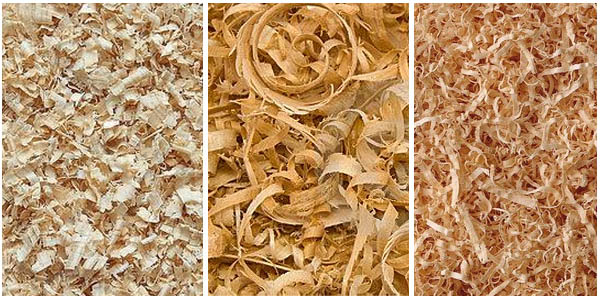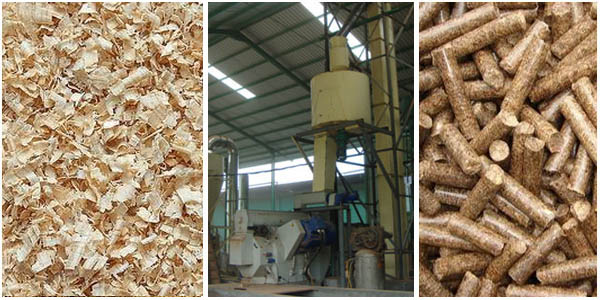How to make quality sawdust pellets
Nowadays, all kinds of biomass pellets are applied by home users, small and medium scale power plants, heating boiler and so on. Among different kinds of biomass pellets, sawdust pellets are most widely used, not only because of their broad raw material origin, but also because of their high heat value (3700-5000kcal/kg, higher than other biomass pellets).
As the sawdust arrived in the wood pellet machine plant, the moisture content should be tested. The moisture content gives the proportion of evaporable water in the total weight of material. The sawdust with high moisture content should be stored separately from the low moisture content sawdust. The production of 1 ton pellets needs the about 7 bulk m3 sawdust with the moisture content around 50-55%. The optimum moisture content of the sawdust is 10-15%. The sawdust with higher moisture content should be dried before entering the wood pellet machine while the lower one can skip the procedure. If you want to know more about raw material moisture, read this article.
Materials
Wood pellets are usually made from clean conifer sawdust and planer shavings. The wood must have been debarked prior to passing through the saw mill. Sawdust of hardwoods can be missed in with that of softwood, but successful production of hardwood pellets without binders is more difficult. If at all possible, dry sawdust and shaving(less than 15% moisture content) are used, because then the drying step can be skipped. If the sawdust is wetter, a drying process is needed before pellets can be pressed.

Storage:
For storage it is preferable to separate wet and dry sawdust. Wet sawdust can be stored for a short period out in the open. The moisture content is not too badly affected if some rain falls on the base materials, and wet sawdust does not blow about as easily. Dry sawdust should be stored indoors immediately to prevent the materials getting wet. If the material is stored outside, the sawdust can blow about and create dust hazards.
Drying
The wet sawdust should be dried before size reduction because the wet sawdust consumes more power to be hammered than the dried one does. And also the wet sawdust may risk the screening by clogging or smearing the screen. Drying can be done by the dryers, a so-called flash drier that works with high temperatures, or on a flatbed dried, which works at a relatively low temperature. The first option is better suited for fine material, while coarse material needs a lower temperature. So, if chips are going to be mixed in, a flatbed drier is preferable.
The heat for the drier can be supplied by any kind of fuel, e.g. gas, oil or even biomass. The biomass boiler could use bark, wood chips, short rotation coppice or other wood waste that is not suitable for pellet production.
Screening
The screening of the sawdust is to remove the stones, plastics, metals, or other hard materials that may damage the equipment. The stones and stone like hard materials are removed by a stone trap when the sawdust passes over the screen while the metals are picked up by a magnet. Sawdust should also be passed over a magnet that removes metal objects. Foreign particles in the sawdust are likely to damage the press or could conceivably cause sparks in the hammer-mill, which might lead to a dust explosion.
Hammering
The hammering is meant to homogenize the sawdust to an even-size. In the piles and piles of sawdust there are might be wood lumps, dead knots, etc. which needed to be hammered so that they can pass the die holes of the wood pellet machines. The mixing of the materials is also completed here. The hammer-mill should be equipped with a venting hatch to the outside of the building. If a dust explosion occurs, the membrane in the escape hatch will blow out and ventilate part of the pressure to the outside of the building. The opening of the vent on the outside of the building needs to be located at a sufficient height or cordoned off in a way that reduces the propensity for injury.
Again, the hammer-mill will not necessarily have the same capacity as the presses, so there should be an intermediate store of hammer-milled material. This material is very fine and very dry, so precautions against fire should be taken. This part of the building should only be entered when wearing a face mask with a dust filter.
Pelletizing
When the sawdust goes into the pelletizing chamber of the wood pellet machine, the lignin of the sawdust will be heated up to 120-130°C by the heat produced by the running wood pellet machine and by which the lignin will be plasticized and binds the particles together to help to mold the pellets. The pellets are molded by being pressed through the pellet dies of the wood pellet machines and then are cut off by the cutter with the desired length. During the pelletizing, the binder may be needed to improve the pellet strength and durability. Vegetable oil is added to lubricate the last pellets at the end of a working period.

Usually the presses are kept operating overnight, because the matrix and the whole machine operate best at an elevated temperature. Many pellet plants operate from Monday morning until Friday afternoon on a continuous basis. This is another reason for having intermediate storage following drying and hammer-milling. Otherwise the press can run out of raw material if it is in continuous operation for periods of up to five days.
Cooling
The moment when the pellets leave the wood pellet machines, they are hot and plastic. Then they need to be cooled down to become hard and rigid and to dry up so that the final moisture content after the cooler can be as low as 6% which may be increased up to 8 to 10% by absorbing moisture from the surround air. After cooling the pellets are transported by conveyor belt to the storage shed, where they condition.
Packaging
Before packaging, the pellets will be screened again for recycling the fines. And then the pellets will be packaged. For domestic users, the pellets are preferred to be packed into bags with the sizes of 12, 15, or 20 kg. While for exporting, the pellets are usually shipped in one tone bags or in bulk which are usually wrapped in plastic to keep the moisture out. Compare with the large bulks or bags, the small bags are better for the pellets because the pellets are subject to less abrasion during delivery.
Pellets delivered in bulk can be transported by truck, tipped off at the receiving end, or be transported by a vacuum vehicle that sucks up the pellets in the factory and blows them into the silo at the receiving end. These trucks are also equipped with weigh cells so that they can measure the exact amount that is delivered.Pellets delivered by truck should always be dumped inside a building or in absolutely dry weather conditions.
Storage
During summer, the production of wood pellets probably exceeds the demand and the pellets may have to be stored for several months. The storage facility should bee constructed of high concrete side walls that can withstand the pressure of the pellets. As stated, pellets easily disintegrate once they get wet, so it is very important that the building is water-tight, to prevent rain or condensation.
Quality testing
During production it is advisable to check pellet quality at least once a day. A sample is taken and fines are sieved out. The resulting sample is weighed and tested for durability in a durability tester. After tumbling the required number of revolutions, the pellets are screened again and weighed again. The amount of whole pellets should be in excess of 97.5% to classify as good grade wood pellets.
A check should also be made for the amount of fines before the pellets leave the plant. At the final point in the production line the amount of fines in the goods should not exceed 1%.
A declaration should be delivered with the pellets describing the raw material used, their durability and fines content, as well as their moisture content. If the figures are available, it is also useful to declare the energy and ash content.
Sawdust pellets content and quality analysis
Since the determination of the content of sawdust pellets is connected with the application of relatively complicated apparatus and is also geographically dependent, it is important to know the content of the wood.
The heat value of fuel wood depends primarily on its moisture content, which is governed by its element composition: carbon, hydrogen, oxygen, nitrogen and some extent sulphur, non-compounds-ashes, as well as moisture content.
Generally, the wood comprises 49 -50% of carbon, 43-44% of oxygen, about 6% of hydrogen, 0.1-0.3% of nitrogen and 0.1-1.0 %of ash, The ash contains calcium, potassium, sodium, magnesium, small amounts of phosphorus, sulphur and other elements(UGOLEV, 2001).
High quality sawdust pellets are with low moisture content and high heating energy and efficiency. They are easy to be handed, burned, transported and stored. The sawdust pellets are usually used for heating by larger scale power plants, biomass boilers, and pellet stove and also popular with the household for heating and cooking.
-----------------------------------------------------------------------------------------------------------------------------------------------
Small Pellet Machine Manufacturer-Kingman
Small pellet machine, also called flat die pellet mill or flat die pellet machine, is pinpointed for domestic users who have a small amount of raw material such as sawdust, rice husk and so on.
Sawdust Pellet Machine and Wood Chip Pellet Mill
The new models of sawdust pellet machine and wood chip pellet mill are developed and manufactured eventually by Kingman based upon so many years' accumulation of test and project cases.
Wood Pellet Machines-the best Pellet Machines sold worldwide
So many individuals out there bear the intention of running a wood pellet machine domestically which is quite a fantastic pitch. Therefore, the clients actually have thought it over about producing just a small number of pellet fuel which is easier than to build up a pellet plant.
Development direction of straw pellet machine
Development speeds of straw pellet machine are obvious in recent years. The eleventh Five Year Plan has published the policy of develop and utilize of biomass pellet fuel.
News
- Issues that need to concerned during the applying of straw pellet mill
- How to make quality sawdust pellets
- Maintain of Screw Extrusion Pellet Mill
- Renewable resources get more subsides from the UK government
- Wood pellet mill is becoming pioneer of energy-saving and emission-reduction
- fuel per year(project) is being built in Chang Bai County Jilin provinces
- Shandong province has first exported biomass fuel
- Further processing of corn straw pellet
- India is developing biomass energy
- Drax secures forward power sales despite tough market
- How to use wood pellet stoves
- More pellet plant is being built
- Eco-friendly smokeless straw pellet fuel
- Factors which affect the compacting performance of biomass pellet fuel
- Biomass briquetting fuel is facing a good opportunity to make progress
- FAQ of Pellet
- Screw Type Extrusion Pellet Mill
- Compression Ratio of Pellet Mill
- Improving air quality through promotion of biomass stoves - KMEC Pellet Plant
- Effect of pore size of sieve to the production of straw pellet mill
- Wood Pellet Mill For Sale
- Wood Pellet Mill in China
- Wood Pellet Mill Machine
- The Southeast Asia pellet market is in depression
- Development prospect of fuel made by biomass pellet mill of Jilin province






